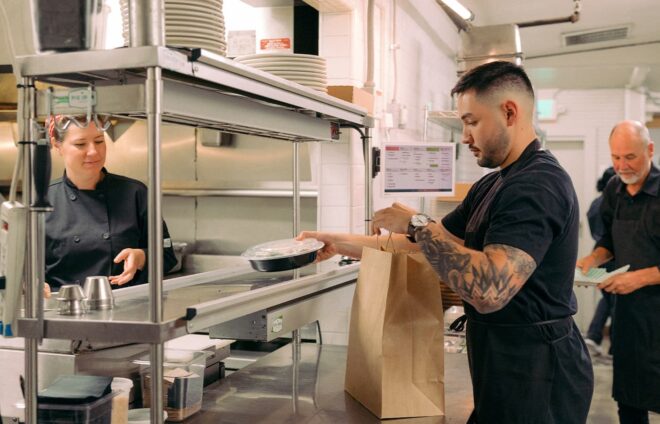In this second of a four-post series featuring local retailers, see how Clover POS has helped these merchants better understand their businesses–with comprehensive sales reports that assist in determining optimal sales days and times, take the guesswork out of paying taxes, and organize wares by sales categories.
Optimize your store’s hours
Clover’s reporting gives you actionable business insights to help better inform your business decisions. Even better, it’s available right on your POS, mobile device, or anywhere you access your Clover Dashboard. You can run customized reports to identify important metrics like your best-selling items, busiest days of the week, or even busiest times of the day, giving you insights to help you maximize sales opportunities.
Mauren Highland is Executive Director of the Petaluma Educational Foundation, a 501(c)(3) non-profit that oversees the Alphabet Soup Stores in Petaluma, CA. Coordinating incoming donations for this secondhand home goods and clothing retail shop is a challenge on its own–let alone finding optimal times to sell those products.
“With Clover reporting, we can see what categories of inventory we’re selling at different points of the season, year, and day. We’re able to make some business decisions with that information like how long our hours should be, or if we need to shift those,” explains Highland. “When we first reopened after COVID, we all had limited schedules we could keep. So looking at that minute-by-minute transaction history, we could really do a study on what was best for us. The system has been able to give us that hard data that we weren’t necessarily tapping into previously.”
READ: How Clover helps retailers run their businesses: Inventory edition
Monitor your taxes
Tami Cox consults her business reports frequently for snapshots of her sales. What’s most helpful for running Country Friends of Ohio, however, is seeing a clear view of the sales taxes she owes.
“When it comes time to pay my sales tax every month, I can run a report right from my Clover system, which is absolutely great,” Cox notes. “It has streamlined everything for me.”
Support other local entrepreneurs and artisans
With its unique business model, The Hidden Gem is run by Brandy Tipper and family in Okotoks and Calgary, Alberta. Without clear sales reporting and insights, Tipper’s business model–a vendor market that provides booths and manages payment processing for over 80 different vendors at the two locations–wouldn’t be possible.
“We keep things organized by giving each of our vendors their own category in the system,” Tipper explains. “We put each of their inventory items in their category and then I can go in and get an item sales report, which breaks everything down.”
Armed with that data, Tipper can help her vendors understand what’s working and what’s not–even on a week-by-week basis.
“I print out a mid-month report for each vendor, and I export every one of their spreadsheets, and email it to them around the 15th of the month. That gives them an idea of what sold within the first two weeks of the month and helps them plan their restocks a little bit better,” Tipper shares. “Then at the end of the month, I print out the full inventory sales report and I email it to them along with a breakdown of all the payments and that kind of thing, and then I can pay them accordingly.”
Sell on consignment
There are more ways retail businesses can facilitate sales on behalf of other vendors and entrepreneurs–like consignment. For merchants who may be new to business and want to build an inventory, selling products on consignment can be a great way to offer an expanded inventory to customers while supporting makers, artisans, or other members of the community.
For Charley Taylor, owner of Fine in Oceanside, CA, supporting local artists is central to her business model.
“I wanted to have stuff from other makers and artists locally and around the world. Right behind the store is what we call ‘Artist Alley,’ and there’s multiple events happening each month with local artists.”
When Taylor was choosing a retail POS, she “wanted Clover to be the best one because it’s the best looking one. And luckily, it is.”
Beyond its good looks, Clover lets Taylor seamlessly integrate wares on consignment within her store and track how much to pay out to each local artist.
Supporting local artists was a surprising plus to Krystal Offord as she journeyed into retail. After finding her dream storefront, Offord decided a sun-drenched loft space would make a perfect art gallery. There, she features rotating exhibits by local artists as part of First Fridays, a monthly community event at AK Cycle Chic. The artists she features are able to sell their works on consignment through the store.
“Our artists are all on consignment, so I’m able to categorize their art accordingly in the dashboard, and then run monthly reports on the sales to see how much we owe to each artist,” explains Offord. “That’s how we pay them.”
Lisa Samar, owner of Daisy’s Doghouse in Buffalo, NY, also finds joy in supporting local artists.
“I use Clover to track all of my inventory, and I can separate things out by the type of sale,” shares Samar. “I have a lot of local artists that I do commission work with, so all of their stuff is in there sorted by consignment. I use it to run all of my numbers for some of the artists.”
Learn how Clover can help your retail business use sales reports and trends to help grow sales. Contact a Clover Business Consultant today.
CONTACT SALES






